简介
时间轮算法(Timing Wheel Algorithm)是一种用于处理定时任务的算法。它的原理是使用固定大小的时间轮,将时间划分成一系列的时间槽(time slot),每个时间槽表示一个时间间隔。每个时间槽关联一个任务列表,用于存储在该时间间隔内需要执行的任务。通过不断地移动时间轮,将过期的任务取出并执行。
时间轮算法的核心思想是通过时间槽来组织任务,并通过固定时间间隔来触发任务的执行。时间槽之间的间隔是固定的,可以根据需求设定。在每个时间间隔到达时,时间轮会将当前时间槽中的任务执行,并将在下一个时间间隔到来时加入新的任务。文章来源:https://www.toymoban.com/news/detail-802718.html
优缺点
优点
- 高效:时间轮算法通过链表等数据结构存储任务,执行任务时可以快速定位到需要执行的任务,并且时间轮的移动操作是常数时间复杂度的。
- 简单:时间轮算法的实现相对简单,易于理解和调试。
- 高度可扩展:通过调整时间槽数量和时间间隔,可以灵活地处理大量的定时任务。
缺点
- 时间精度限制:时间轮算法的时间精度受时间槽数量和时间间隔的限制,无法处理需要更高精度的定时任务。
- 定时任务处理时间限制:如果执行某个任务所需时间超过时间间隔,可能会造成任务堆积或错过任务的执行。
应用场景
时间轮算法在实际应用中广泛用于计时器、定时任务调度等场景,例如网络编程中的超时管理、定时器线程等。常见的网络框架和库,如Netty、NIO、libevent等也都使用时间轮算法来处理定时任务。文章来源地址https://www.toymoban.com/news/detail-802718.html
示例代码
class TimerWheel {
constructor(slotSize, tickDuration) {
this.slots = [];
this.tickDuration = tickDuration;
this.slotSize = slotSize
this.currentSlot = 0;
this.timer = null
}
init () {
for (let index = 0; index < this.slotSize; index++) {
const slot = []
this.slots.push(slot)
}
this.advance()
}
release () {
clearTimeout(this.timer);
}
addTask(task, delay) {
const targetSlot = (this.currentSlot + Math.ceil(delay / this.tickDuration)) % this.slots.length;
this.slots[targetSlot].push(task);
}
advance() {
clearTimeout(this.timer);
const tasksToExecute = this.slots[this.currentSlot];
// console.log(this.currentSlot, tasksToExecute);
this.slots[this.currentSlot] = [];
tasksToExecute.forEach(task => task());
this.currentSlot = (this.currentSlot + 1) % this.slots.length;
this.timer = setTimeout(this.advance.bind(this), this.tickDuration);
}
}
// 例子:创建一个包含10个槽,每个槽表示100毫秒的时间轮
const timerWheel = new TimerWheel(10, 100);
// 启动时间轮
timerWheel.init()
// 添加定时任务,在延迟300毫秒后执行
timerWheel.addTask(() => {
console.log("Task executed after 300 milliseconds");
}, 300);
// 停止时间轮
// timerWheel.release();
到了这里,关于【一天一个算法】---时间轮算法的文章就介绍完了。如果您还想了解更多内容,请在右上角搜索TOY模板网以前的文章或继续浏览下面的相关文章,希望大家以后多多支持TOY模板网!









